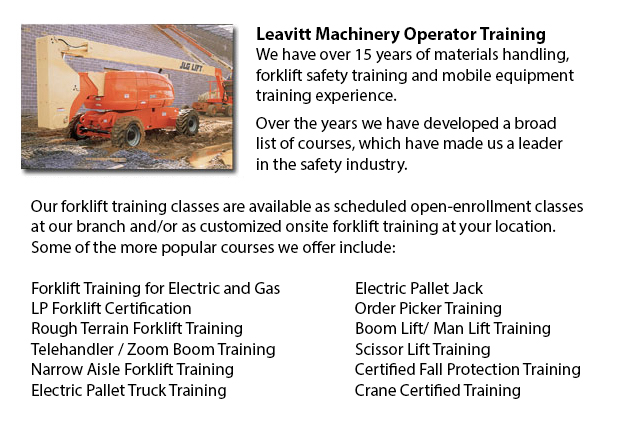
Kitchener Manlift Training - There are lots of manlift training programs which offer a review of the manlift equipment. The practicum portion of the training is another important part of the course. In this part the trainee has chance to demonstrate their practical abilities, their ability to safely operate a manlift. A prerequisite to Manlift training is the fall protection training, that can be incorporated in the training based on the particular requirements of the client.
Course Content
The program comprises the following areas of instruction: pre-shift equipment check and work area survey requirements; the impact of doing unsafe acts or using unsafe machines, Lifting device equipment definitions, Review of load capabilities, the particular equipment requirements and safety decals, Review of related sections of the CSA Standards as well as the OHSA Standards and Review site particular Hazards, together with controls for safe utilization of a lifting device.
Demonstration and Evaluation Content
The demonstration and evaluation part of the course includes: Using a signaler or a spotter when needed; Proper personal protective equipment or also referred to as P.P.E. as needed; using a lift only on level and solid ground; Using a correct fitting harness or fall arrest device; Operating the lift with all other workers clear of the job place; Aware of load limitations etc. and other specs as set out by the manufacturer; Pre-shift work area survey and machine inspection; Having all associated equipment safely stored on the lift platform; Isolating off the work area when major work projects are to be carried out; and ensuring a safe and smooth operating speed for different plant conditions
Each of the trainees will undergo testing to make sure that they can safely operate their machine.
Manlift Safety
Manlifts can be really dangerous machines as they are capable of lifting an employee 20 feet or higher in the air and that creates a particular amount of risk. Because the danger is so apparent, lift operators and owners are careful to correctly maintain their equipment and follow proper operating procedures and safety precautions. The ratio of accidents involving this specific machinery is fairly low.
The safe utilization of the scissor lift, manlift and the boom lift is up to the operator of that machine. They need to know all of the responsibilities that go with operating the equipment and how to use the lift vehicle safely. The most basic safety features on the equipment are safety decals and the operating handbook. These show vital information about the maintenance, operating procedures and safety machines.
A new model of manlift would come with the needed decals in place and operating manuals. The operating handbook must be found on the machine at all times. If you are buying a second-hand lift, it is essential to ensure that the instruction manual is included and that vital decals haven't been painted over. The restraints which prevent operators from falling and the guardrails are other essential safety features. These are standard and mandatory on all kinds of lifts.
-
Kitchener Forklift Training Schools
Kitchener Forklift Training Schools - The Advantages Of Taking One Of Our Forklift Training Schools Are you searching for work as a driver of a forklift? Our regulatory-compliant mobile equipment operator training offers instruction in types of fo... More -
Kitchener Overhead Crane Operator Training
Kitchener Overhead Crane Operator Training - Our overhead crane operator training course is designed to teach employees the basics of overhead crane/sling operation and pre-shift checks. Courses are taught by our expert trainers and consultants. Well... More -
Kitchener Crane Training School
Kitchener Crane Training School - The crane training school offers industry-relevant programs. Courses provide trainees with learning outcomes which match present industry demands. Our small class sizes combine hands-on experience and theory. Our qua... More -
Kitchener Skid Steer Ticket
Kitchener Skid Steer Ticket - The lift arms on the skid-steer loader are located at the side of the driver along with pivots behind the driver's shoulders. These features makes the skid-steer loader different as opposed to the conventional front load... More -
Kitchener Manlift Operator Certification
Kitchener Manlift Operator Certification - Our scissor platform and aerial lift training and certification empowers participants with a knowledge and general understanding of the efficient and safe use of "Power Operated Mobile Work Platforms," under... More -
Kitchener Crane Safety Training
Kitchener Crane Safety Training - Companies and crane operators have to be aware of the problems related to crane safety. Legislation provides rules for the safe operation, inspection and maintenance of lifting machines all around North America. Cran... More -
Kitchener Forklift Training Programs
Kitchener Forklift Training Programs - Are you searching for work as a forklift driver? Our regulatory-compliant mobile equipment operator training offers instruction in kinds of forklifts, pre-shift check, fuel kinds and dealing with fuels, and safe... More -
Telehandler Training in Kitchener
Telescopic handlers often known as telehandlers for short, are an extremely popular piece of heavy construction machinery. They are commonly used in the construction and agricultural industries. These equipments have extreme reaching ability and can... More

Forklift Certification Kitchener
TOLL FREE: 1-888-254-6157
Kitchener, Ontario
forkliftcertificationkitchener.com
Email Us
About Us


